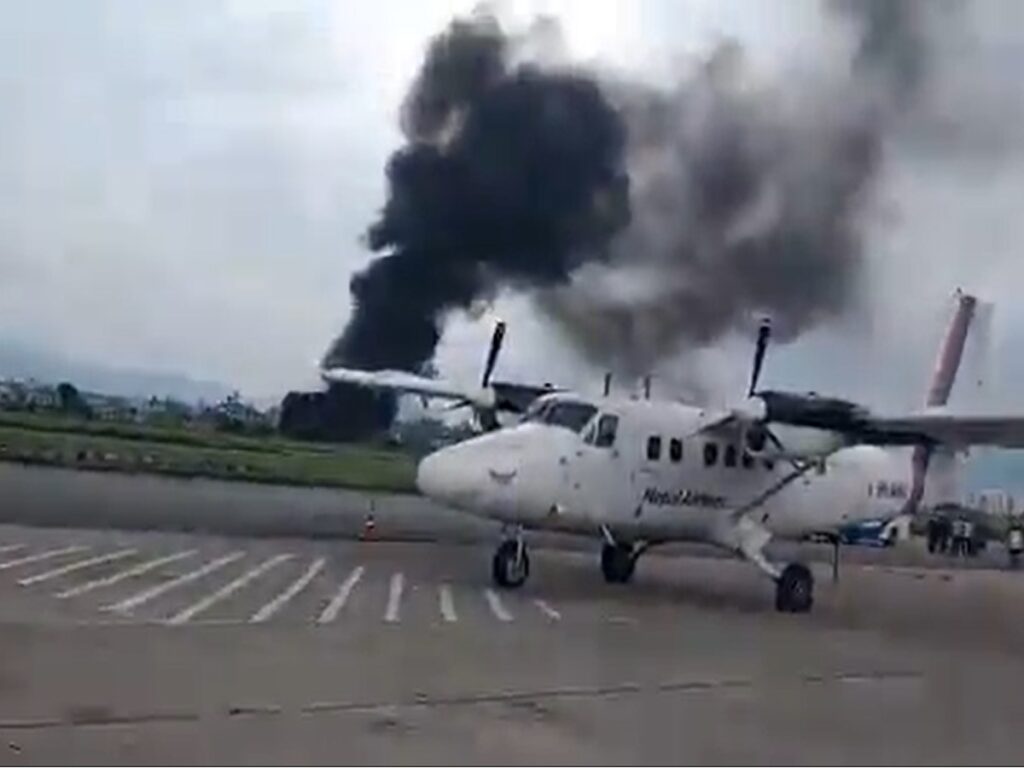Smoke in the Nepal Airport
Tragic Incident in Kathmandu
On Wednesday morning, a passenger plane carrying 19 people crashed during takeoff in Nepal’s capital, Kathmandu. Fire crews immediately rushed to douse the flaming wreckage.
Details of the Crash
The Saurya Airlines plane crashed at around 11:15 am (0530 GMT). Nepal’s military confirmed this in a statement. The army’s quick response team assisted in the rescue efforts. However, the general manager of Kathmandu airport, Jagannath Niroula, stated that details were still being confirmed.
Passengers and Crew
The Kathmandu Post reported that the flight carried 19 people, including the aircrew. The news portal Khabarhub mentioned that the airplane caught fire after skidding on the runway. A significant plume of smoke was visible from the wreckage.
Destination: Pokhara
The plane was en route to Pokhara, a crucial tourism hub in the Himalayan republic. Saurya Airlines, which exclusively flies Bombardier CRJ 200 jets, operates this route frequently.
Nepal’s Air Industry Boom
In recent years, Nepal’s air industry has boomed, transporting goods and people between hard-to-reach areas. This industry also serves foreign trekkers and climbers. However, poor safety standards have plagued it. Insufficient training and maintenance are significant issues.
Safety Concerns
The European Union has banned all Nepali carriers from its airspace over safety concerns. Nepal’s aviation safety record is woeful and compounded by its challenging geography. The country has some of the world’s trickiest runways. These runways are flanked by snow-capped peaks, posing challenges even for skilled pilots. Moreover, the weather in the mountains can change rapidly, creating treacherous flying conditions.
Previous Accidents
Nepal’s last major commercial flight accident occurred in January 2023. A Yeti Airlines service crashed while landing at Pokhara, killing all 72 aboard. This accident was the deadliest in Nepal since 1992. In that year, all 167 people aboard a Pakistan International Airlines plane died when it crashed on approach to Kathmandu airport. Earlier in 1992, a Thai Airways aircraft crashed near the same airport, killing 113 people.
Immediate Response
Following the crash, rescue teams worked tirelessly to save lives. However, the severity of the crash made their job challenging. Eyewitnesses described the scene as chaotic, with thick smoke billowing from the wreckage.
Investigation Underway
Authorities have launched an investigation to determine the cause of the crash. Preliminary reports suggest that the plane may have encountered technical difficulties during takeoff. However, officials will need more time to provide a comprehensive analysis.
Impact on Families
Families of the passengers and crew members are devastated. They anxiously await news about their loved ones. The airline has promised to keep the families informed and provide support during this difficult time.
Aviation Experts’ Views
Aviation experts stress the need for improved safety measures in Nepal’s aviation sector. They believe that better training and maintenance can prevent such tragedies. The experts also recommend stricter regulatory oversight to ensure compliance with international safety standards.
International Reactions
The international community has expressed condolences and offered support. Neighboring countries have offered to assist in the rescue and investigation efforts. The crash has once again highlighted the need for global cooperation in aviation safety.
The Future of Nepal’s Aviation
Despite the challenges, Nepal’s aviation industry continues to grow. However, this growth must be accompanied by a commitment to safety. The government and airlines must work together to address the underlying issues and ensure the safety of passengers and crew.
The plane crash in Kathmandu is a tragic reminder of the risks associated with air travel, especially in challenging environments like Nepal. As the investigation unfolds, authorities must focus on preventing future accidents. Improved training, maintenance, and regulatory oversight are crucial steps toward achieving this goal.
In summary, the crash has left a profound impact on the families of the victims and the nation as a whole. The international community stands with Nepal during this difficult time. Together, we can work towards a safer aviation industry for all.



